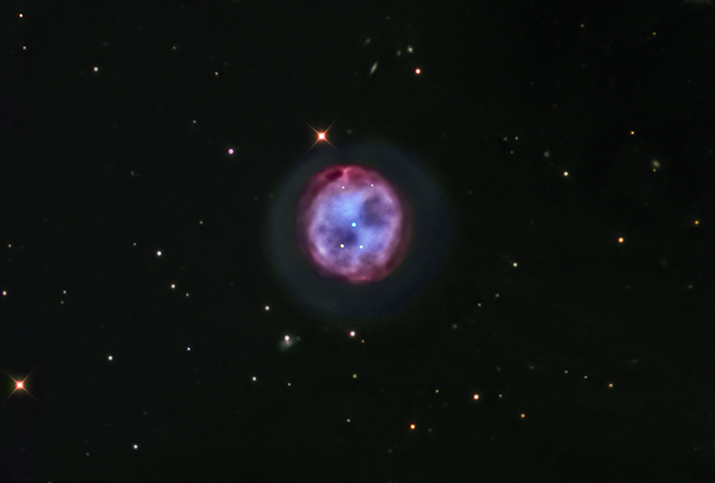
|
Date: Apr. 19 20 21 26, 2015 - Location: Denton, TX Telescope: ATRC12 Mount: MI-250 Camera: ST-10XME Filters: Astrodon TruBalance Exposure: Lum = 2 hours, Ha = 4 hours, OIII = 6 hours, Red, Green & Blue = 1 hour each Guided using Innovations Foresight On Axis Guider (ONAG) Click on the image below to view at higher resolution. |

|
M97, commonly known as The Owl Nebula, is located approximately 2,300 light years away in the constellation Ursa Major. M97 is a planetary nebula and is approximately 8,000 years old. It was formed from the outflow of material in the form of stellar wind from the central dying star. It consists of 3 concentric shells that were expelled at different stages in the death throes of the central star. The outmost shell is very faint and often is not resolved in traditional RGB color astronomical images. This feature however is resolved in long duration OIII filtered data. The next, or middle shell, radiates in the red light from excited hydrogen gas. The bright central core of the nebula consists of the combined emission from hydrogen, helium, nitrogen, oxygen, and sulfur. The central star has reached the point where it is condensing into a white dwarf and has a surface temperature of approximately 221,000 degrees Fahrenheit. The image above was assembled as a LRGB color image where the luminance channel consists of a combination of Luminance + Hydrogen Alpha + Oxygen III filtered data. The faint outer shell, or halo, is from OIII filtered data, the nebula core is primarily from the Ha filtered data, and the stars and background objects are from the Luminance filtered data. The color is primarily from traditional Red, Green, and Blue filtered data. 1http://en.wikipedia.org/wiki/Owl_Nebula
|